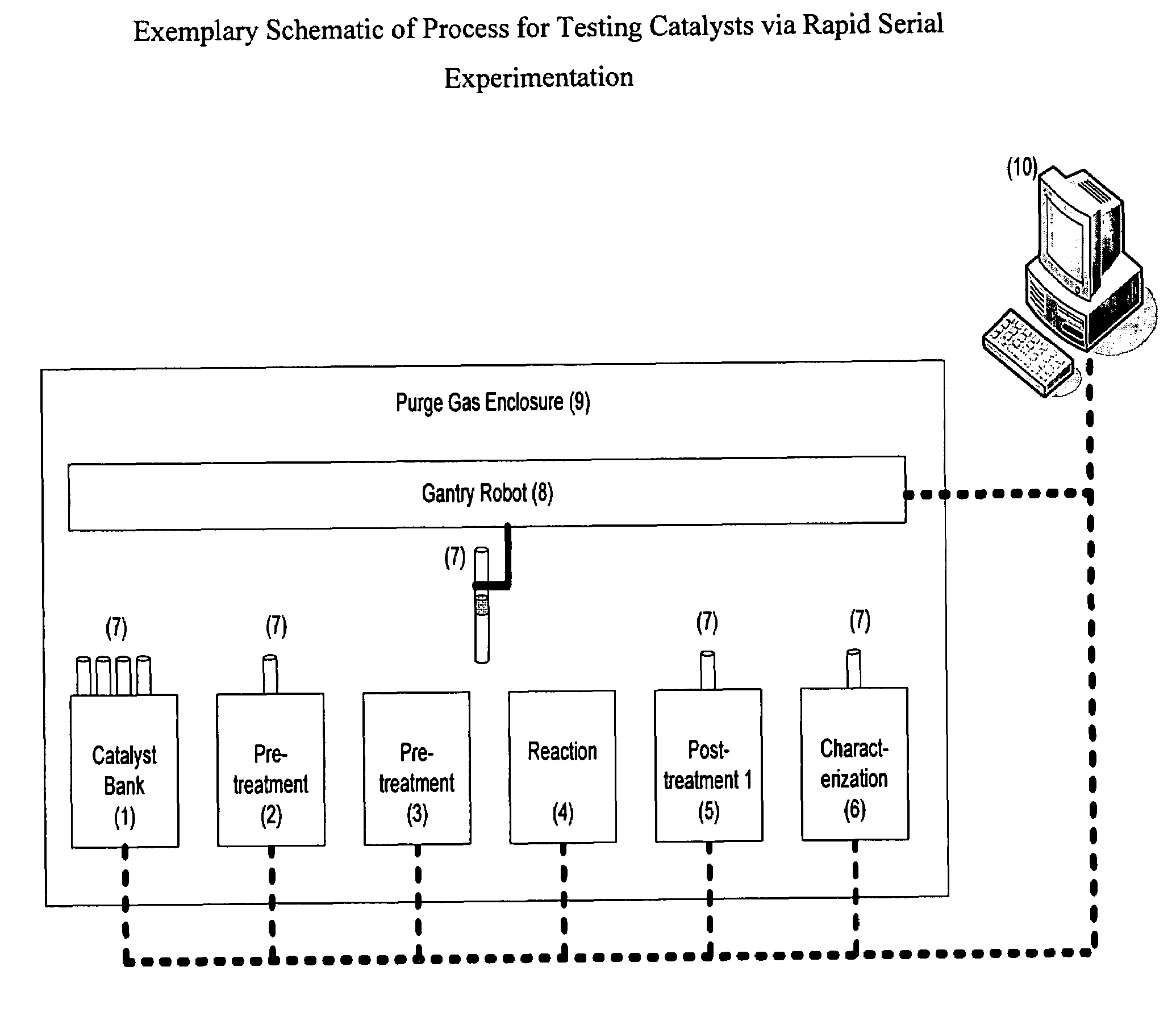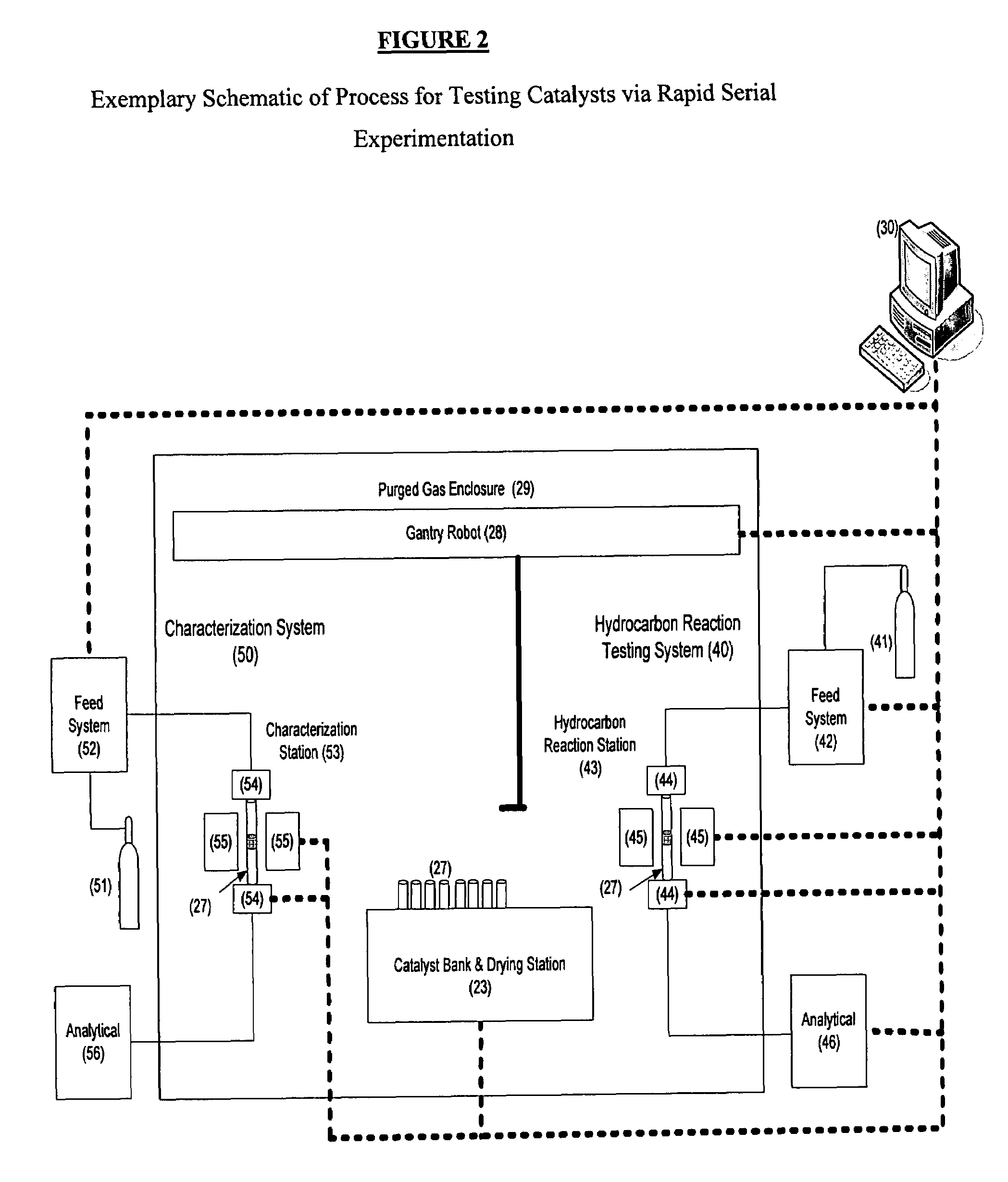Rapid serial experimentation of catalysts and catalyst systems
a catalyst and serial experiment technology, applied in the field of catalyst testing, can solve the problems of unreliable methodology, low efficiency of de19809477c2, and slow step in the sequence characterization of catalysts, and achieve the effects of short reaction time, improved efficiency, and faster cycle of reactors
- Summary
- Abstract
- Description
- Claims
- Application Information
AI Technical Summary
Benefits of technology
Problems solved by technology
Method used
Image
Examples
example 1
[0054]A storage station or tray of pre-calcined catalyst packed tubular reactors (0.25 g each) was placed in the ante-chamber of a glove box. The ante-chamber was evacuated then nitrogen purged to 4 inches of water (gauge). The tray was then transferred to a heating block within the inert atmosphere of the glove box. The heating block already contained several trays currently in use for reaction testing and de-coking. Twenty-five catalyst packed reactors, situated in the trays in the heating block, had come to a steady-state temperature of 120° C. Each reactor within the heated tray were also continuously exposed to an inert purge to dry each catalyst for sufficient time so that each catalyst packed reactor was considered appropriately pre-treated and available for hydrocarbon testing. Automated robots selected a reactor tube from the pre-loaded tray and transferred it into the hydrocarbon assembly for testing. A furnace at 400° C., consisting of two sides, was then actuated (roboti...
example 2
Comparative
[0057]A reactor is packed with 0.25 g of catalyst. The reactor was manually loaded into a conventional 3 zone furnace assembly (required about 0.5 hr). It was pressure tested and then heated from 30° C. to 120° C. at 1° C. / min and held for 1 hour to enable drying (total time of 2.5 hours). The catalyst packed reactor was then heated to 800° C. at 5° C. / min. Hydrocarbon gas was then fed and allowed to react for approximately 1 hour. Total time for reaction was approximately 3.3 hours. Because of the mass of the traditional furnace and without fans, cool down required about 2 hours. At the same time, a sample of spent catalyst (different) was loaded on to a set-up to complete temperature programmed oxidation from 25° C. at 5° C. / min to 800° C. Because the reactor had to be unloaded, and a TGA (Thermogravametric Analysis Instrument) pan loaded, 0.5 hrs was required to load the instrument. In addition, without an inert atmosphere, the oxidation had to be begun at 25° C. inste...
example 3
[0060]The method of example 1 whereby the process flow was controlled via differential pressure across a critical orifice or by use of an automated variable orifice, such as a valve.
PUM
| Property | Measurement | Unit |
|---|---|---|
| steady-state temperature | aaaaa | aaaaa |
| time | aaaaa | aaaaa |
| time | aaaaa | aaaaa |
Abstract
Description
Claims
Application Information
 Login to View More
Login to View More - R&D
- Intellectual Property
- Life Sciences
- Materials
- Tech Scout
- Unparalleled Data Quality
- Higher Quality Content
- 60% Fewer Hallucinations
Browse by: Latest US Patents, China's latest patents, Technical Efficacy Thesaurus, Application Domain, Technology Topic, Popular Technical Reports.
© 2025 PatSnap. All rights reserved.Legal|Privacy policy|Modern Slavery Act Transparency Statement|Sitemap|About US| Contact US: help@patsnap.com



